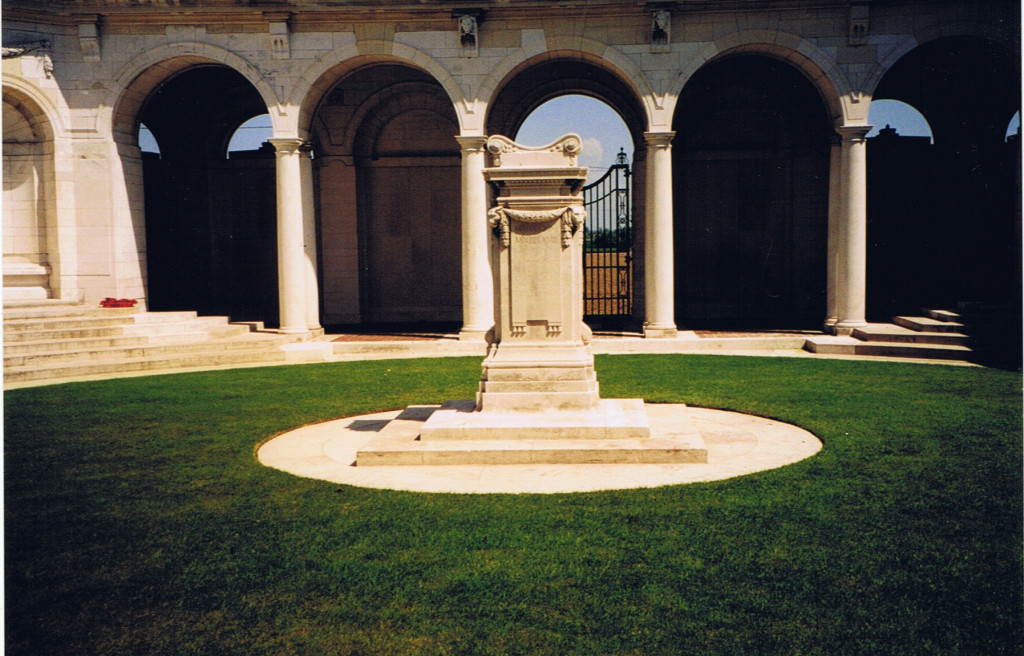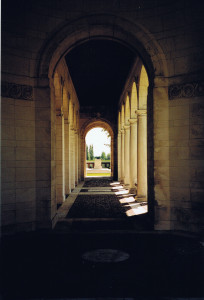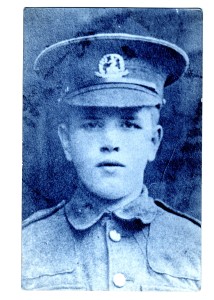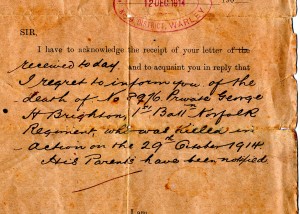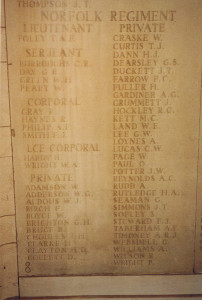On 4th August 1914 Britain declared war on Germany and immediately began to mobilize its army with the intention of stopping Germany’s advance into France via Belgium. George Brighton was a regular soldier with 1st Battalion, Norfolk Regiment, stationed in Holywell, Belfast. The Norfolk Regiment was one of the regiments which made up the 15th Brigade which landed at Le Havre on 16th August 1914. They travelled from there by train to an area near Busigny from where they marched towards Belgium.
The area they arrived at in Belgium was industrialised with factories and coal mines. The Norfolks were billeted in factories. With the help of local miners the Brigade dug trenches but it was a difficult area to fight in because of coal mines, railways, slagheaps and canals. The Norfolk Regiment was involved in the Battle of Mons on 23rd to 24th August and also at Elouges. After these battles the Brigade was told to retreat. This they did through the night with little rest and few rations. Over the next ten days they travelled towards the south west edge of the Forest of Compiegne., sleeping in barns or bivouacking in fields. There seemed to be a lot of confusion as to where they were heading. One of the officers went into a stationer’s shop and bought local maps of the area, as their maps did not cover the locality they were in.
On 6th September their orders changed and they were sent back again towards the Front line. The regiment engaged with the enemy on several occasions during the following weeks and suffered losses. At Missy the Norfolk Regiment led the assault and some of the men were killed or buried under falling houses and buildings.
By the end of October the Norfolk regiment was in an area near Bethune in northern France, near the small village of Festubert which had recently had its population evacuated. The area was very swampy, wet and muddy with heavy black, greasy clay. From the middle of September it had rained heavily and was becoming cold.
On the morning of 29th October the Germans launched a violent attack at dawn on the Devonshire Regiment and then at 7 a.m. on the Manchester Regiment, who ran short of ammunition and had to use their bayonets. The Norfolk Regiment was sent to give support.
A commanding officer of the Brigade wrote in his diary,
“I sent one company of Norfolks to support the Devons, but I could barely afford even that. The enemy was entrenching within 200 to 400 yards of all my battalions”.
Because of the difficulties the Norfolk regiment was not relieved until the next day.
George Henry Brighton was killed on 29th October 1914 as were other men from the Norfolk Regiment and so it is presumed he was killed in this battle. He has no known grave and is remembered on the Le Touret Memorial, Pas de Calais, France.
George Henry Last Brighton was born on 24 October 1893 in the Union Workhouse in Swainsthorpe, Norfolk. His mother Elizabeth Martha Sophia Brighton was only 18 when he was born and unmarried. She was working at Shotesham watermill as a servant before he was born. In 1896, aged 3, he was living in the workhouse with his mother and was in and out of there eight times during his childhood. He had one sister, Norah, born in 1895, and two brothers, Alfred, born in 1900, and Alan, born in 1910. Like George they were also born in the Union Workhouse. His mother worked as laundress or as a charwoman. In 1913 Elizabeth married Leonard Savage and went on to have three more children, Gladys born in 1914, Ronald in 1915 and Raymond in 1918.
George spent most of his life in Saxlingham Thorpe. He lived with his mother, grandmother, Maria Sophia Crane, and his step grandfather, Arnold Damascus Crane, and their children at Smockmill Cottage, Cargate Lane, Saxlingham Thorpe. In 1911 George, aged 17, was still living with his grandparents and was working as a roadman. His mother was in the workhouse with a baby and working as a laundress. His sister Nora was working in Norwich in a fish and chip shop and his brother Alfred was in a children’s home in Framingham Pigot.
As George’s service records are not available it is not known when he joined the Norfolk Regiment. However his medal records show that he landed in France on 16th August 1914 and therefore was a member of the Regiment before the start of the war. On 1st October 1914 there was a news report in the Eastern Daily Press that Private Walter Colman of 1st Norfolks had been wounded but was progressing favourably in hospital. In a letter to his wife he stated that Private G. Brighton of Saxlingham Nethergate “is all right” It is presumed that he had therefore been involved in fighting during the previous weeks before his death on Thursday 29th October 1914.
Acknowledgements.
Census Records 1901, 1911
Eastern Daily Press. 1 October 1914
Edward Lord Gleichen, The Doings of Fifteenth Infantry Brigade. (The Project Gutenberg e book)
British Army WW1 Medal Rolls Index Cards
UK Soldiers, Died in the Great War, 1914-1919
Thanks to Dionne Savage (Great-niece) and Savage family for family information and photographs.

